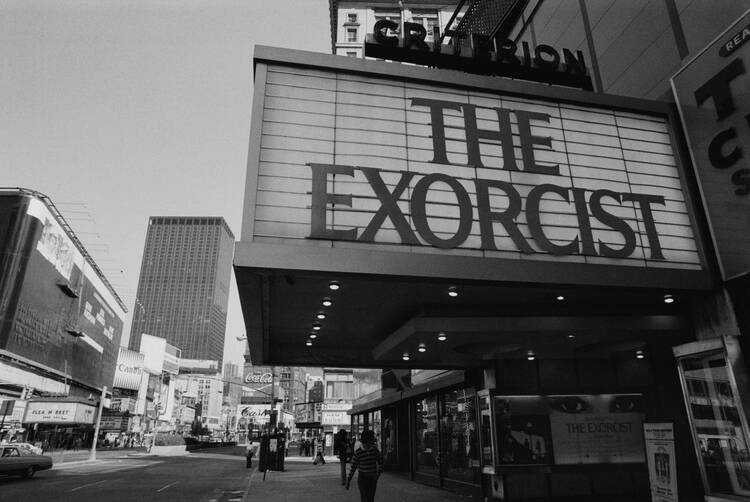This review contains spoilers for “The Exorcist: Believer.”
Popularly known as the Vatican’s exorcist for his decades-long work in Rome, the Italian-born Catholic priest Gabriele Amorth, S.S.P., was a controversial figure. An imposing man with a severe look permanently etched on his face, Father Amorth, who died in 2016, claimed to have performed up to 100,000 exorcisms. Considering his warning that Harry Potter novels could draw children into the occult, it is curious that Father Amorth called “The Exorcist,” the landmark tale of possession directed by William Friedkin that repulsed and astonished audiences with its graphic content, his favorite film.
But the priest’s explanation was simple: “People need to know what we do.”
You will not have any clue what Catholic exorcists do after suffering through “The Exorcist: Believer.”
You will not have any clue what Catholic exorcists do, however, after suffering through “The Exorcist: Believer,” reportedly the first part of a coming trilogy. A pointless pastiche of the original film, a surprise cultural phenomenon and proto-blockbuster that reimagined what could (or should) be shown on screen, this latest disaster plays it safe and muddles the message of the 1973 hit through misguided attempts at ecumenism.
Instead of focusing exclusively on the Catholic rite of exorcism, “Believer” investigates how different denominations drive out demons. It is an interesting premise on paper, but the result is a jumbled mess of disparate religious practices, random biblical references and off-hand allusions about everything from Zoroastrianism to the Dead Sea Scrolls. Here the devil, not God, brings all faiths together. And in investigating everything, the film focuses on nothing. Worst of all, it lacks a certain bite, an edge that made the first film feel dangerous and threatening.
A muddled message
The story is straightforward. Victor Fielding lives with his teenage daughter, Angela, in a fictional town in Georgia. At school, Angela befriends Katherine, a youth group leader in her local church. One night, the girls wander into the woods and host a séance to connect with Angela’s dead mother. (A note to readers: Never perform a séance in the woods.) After three days, the girls are discovered in a barn shaken and bewildered and are taken to the hospital.
Everything goes rapidly downhill from here. When Angela returns home, she appears withdrawn before attacking her father and collapsing on the floor in a seizure. Katherine, meanwhile, makes a public scene at church when she comes wandering down the aisle screaming about “THE BODY AND THE BLOOD” of Christ.
These girls are so possessed that they need an entire team of people to drive the demon out.
These girls are so possessed that they need an entire team of people to drive the demon out. The regular old-fashioned words of Scripture just won’t do. In the end, Angela lives but Katherine dies. What is the message here? Evil prevails sometimes? One out of two ain’t bad? This ending is a complete betrayal of the original film, which for all its foulness and obscenity, portrayed a tortured priest sacrificing himself for the ultimate defeat of evil.
Now the most important question: Is the movie scary? What’s scary is how bad it is. The giant “Exorcist” billboards at Seventh Avenue and 50th Street are more disturbing than this entire film. “Believer” is plagued by shoddy craftsmanship: choppy, frantic editing; an uneven script and dull, uninteresting cinematography that shoots every scene either in low-light or fluorescent greens. Instead of establishing an atmosphere of suspense, the film relies mainly on jump scares—a departure from the foreboding and unrelenting horror of the Friedkin picture.
A thousand spinoffs
Perhaps it is unfair to compare this new film with the Oscar-winning classic that launched a thousand spinoffs, but “Believer” relies so heavily on its much stronger predecessor that comparison is impossible to avoid. Frankly, director David Gordon Green continuously invites comparison to the original. And the similarities are boundless: the flashing demon face, the lights flickering on and off, the use of the “Tubular Bells” theme, the casting of Ellen Burstyn, levitating, head spinning, fighting dogs and so on.
What makes “The Exorcist” great? Magnificent performances, from the towering screen presence of Max von Sydow to the precocious brilliance of a 14-year-old Linda Blair (whose Oscar loss was an injustice), elevate the film from a B-movie schlock piece to a formidable artistic statement. A serious picture that takes its time, there is something particularly terrifying in that most of the film takes place in the home. That quiet 1970s domesticity, a relatively conservative environment immune from the evils of the time, is suddenly invaded by unspeakable filth.
Money, lots of it, can be the only reason why any studio would invest in this franchise.
The film works through category violation, placing things where they shouldn’t be to evoke discomfort and disgust. For example, human waste belongs in the toilet. That is normal. But it would conjure an entirely different reaction if it appeared in your bed. Something where it shouldn’t be. A crucifix should in no way be involved with a sexual act. Urine does not belong on the rug at a sophisticated house party. And the devil certainly does not belong anywhere near that nice little girl.
William Peter Blatty, the Georgetown alumnus who wrote the novel on which “The Exorcist” was based, was interested in the theological drama of a young priest tormented by his struggles with belief who suddenly comes face-to-face with pure evil appearing in the form of an innocent child. “I set out to write a novel that would not only excite and entertain (sermons that put one to sleep are useless), but would also make a positive statement about God, the human condition and the relationship between the two,” wrote Blatty for America in 1974. For him, the novel was an act of faith.
“The Exorcist” also cannot be divorced from its cultural context. Visceral audience reactions to the film, which saw sickened viewers racing out of theaters, are the stuff of legend. Friedkin’s willingness to transcend the limits of good taste made his film both controversial and hugely successful. A member of the New Hollywood movement of the late 1960s and early 1970s, Friedkin’s film premiered at a time when upstart directors with something to prove aimed to push buttons and, if necessary, alienate their parents’ generation. Even the initial trailer was removed from theaters after terrifying viewers.
“The Exorcist” was released on the heels of similarly shocking pictures that heralded a new permissiveness in cinema.
“The Exorcist” was released on the heels of similarly shocking pictures—like “A Clockwork Orange,” “The Last House on the Left,” “Pink Flamingos” and “Last Tango in Paris”—that heralded a new permissiveness in cinema. Any director trying to recapture the impact of “The Exorcist” today, an impossible task, would need to make a decidedly confrontational picture. It should be the kind of transgressive film any respectable studio would hesitate to release—and not because the movie is bad.
There are fair criticisms of Friedkin’s film: its emphasis on shock value over faith, its over-the-top, giallo theatrics (particularly at the end). The late literary editor of America Raymond A. Schroth, S.J., who disliked “The Exorcist” and questioned the legitimacy of demonic possession in general, once told me it was ridiculous that the devil, who supposedly works in darkness and secrecy, would target the daughter of a famous actress living next door to a Jesuit-run university. Father Schroth was critical of the book too: “[Blatty] has brought forth—along with a commercial success—a piece of Catholic nostalgia of more service to the cause of superstition than to true religion,” wrote Father Schroth in Commonweal (11/3/72).
While the public turned out in droves to see the film, waiting in freezing temperatures and endless lines that snaked around city blocks, initial critical reception was lukewarm. Richard A. Blake, S.J., writing one of many reviews of the film for America, faulted the movie for using “the symbols and images of Christianity without preserving their underlying message.” In 2000, however, Father Blake amended his review and described it as “an extremely effective supernatural horror movie.”
A franchise devolves
To get a sense of the franchise’s evolution (or devolution), I watched all five preceding “Exorcist” films in what was surely one of the worst days of my life. (I rewatched the 1973 film last as a sort of perverse palate cleanser.) Following the original picture, the series immediately falls off a cliff, hitting a few rocks on the way down. “Exorcist II: The Heretic” was a historic flop, often ranked among the worst films ever made. It helped end Linda Blair’s once promising career and marked a surprising misstep for the director, John Boorman, previously lauded for his genuinely disturbing “Deliverance,” released five years prior.
The 1977 “Exorcist” sequel finds Richard Burton as a Jesuit priest investigating the death of Father Merrin. It features bizarre hypnosis sessions, unintentionally hilarious ululations, tap dancing and giant locusts. James Earl Jones wears a bug costume in the same year he voices Darth Vader. In perhaps the film’s most ridiculous (and offensive) scene, Regan, again played by a disturbed Linda Blair, magically heals a nonverbal autistic girl at her therapist’s office.“I was possessed by a demon,” says Regan cheerfully. The picture was universally panned, with the notoriously caustic John Simon calling it probably “the stupidest major movie ever made” and Mark Kermode declaring it “absolutely unforgivable.”
The third franchise film, directed by Blatty himself, fared somewhat better but received middling reviews. Starring an excitable George C. Scott as the hardboiled Lieutenant William F. Kinderman, originally portrayed by Lee J. Cobb, this dialogue-heavy film is well written and inventive but ultimately not convincing enough to warrant a follow-up.(Reportedly, “The Exorcist III” had at least one obsessed fan: the serial cannibal Jeffrey Dahmer.)
The most recent two films—“Exorcist: The Beginning” and “Dominion: Prequel to the Exorcist”—star Stellan Skarsgård as a young Father Merrin and provide largely superfluous backstories. They include a lot of Nazis and some truly horrid computerized effects. Several sequels have also featured graphic violence against Black children, which is an entirely different matter for critical investigation. This is a matter for concern and a completely needless innovation in the franchise.
Despite the critical opprobrium, most of the “Exorcist” sequels have turned a profit. Money, lots of it, can be the only reason why any studio would invest in this franchise. Let’s face it: Satan sells. Still, how could Universal, following the embarrassing critical failure of four consecutive films, justify spending a fortune to reboot the series after almost two decades? The decision is, by its very definition, insane—doing the same thing repeatedly and expecting a different result. But the result has always been the same: a largely forgettable night at the movies and, in Universal’s case, nearly half a billion dollars squandered on Satan. My advice? Stop.








